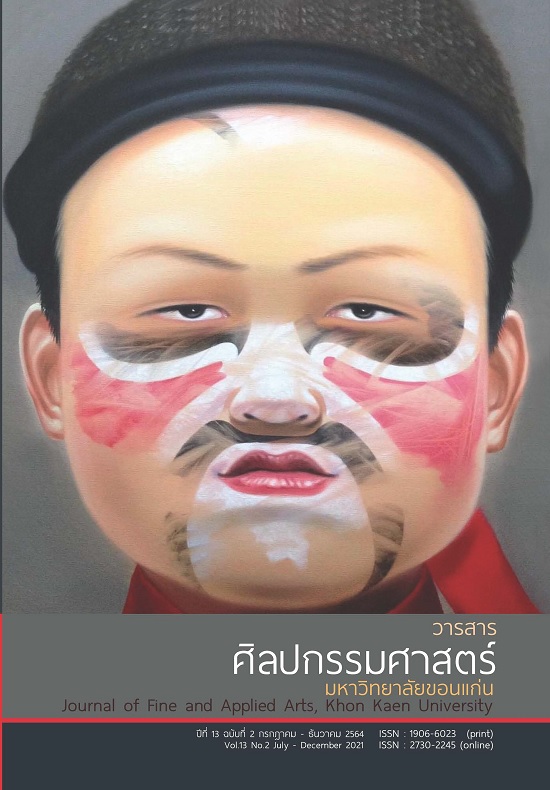Design and development of tourism’s iconic souvenir for The First Royal Factory at Fang Museum
Main Article Content
Abstract
The objectives of this research were 1) to survey consumers’ demand over the souvenirs of the First Royal Factory at Fang Museum, 2) to design and develop tourism’s iconic souvenir for the First Royal Factory at Fang Museum, and 3) to evaluate consumers’ satisfaction with the souvenirs designed by the researcher. The method of this research was conducted to meet the research objectives as follows: 1) Data were collected using open-ended questionnaire from museum staff and consumer demand data were collected from the sample consumers and tourists visiting the First Royal Factory at Fang Museum. The data collection duration was 3 days. The number of respondents was 30. The sample was selected based on a simple random sampling. The research instruments were a checklist questionnaire and rating scale questionnaire, 2) questionnaire on opinions and suggestions from 3 product design experts, 1 marketing expert and 1 museum specialist. The key informants were selected based on a purposive sampling. The research tool was also rating scale questionnaire, 3) satisfaction survey on the designed souvenirs. The respondents were 110 tourists visiting the First Royal Factory at Fang Museum. The data collection duration was 1 week. They were selected based on a simple random sampling. The research tools were rating scale questionnaire. Data were analyzed using statistics, including average and standard deviation to measure consumers’ satisfaction. Analyzed data were then processed using descriptive statistics.
The results of this research indicated that the sample consumers had the highest level of their satisfaction with the designed souvenir under the scoring criteria of 1 = beauty, 2= usefulness, 3= portability, 4= personal use or purchase as souvenir, and 5= suitability. The levels of satisfaction were ranked as follows:
The first rank was "Ben - Bennie" screen printed canvas bag set with (=4.48, S.D.=0.72) The second rank was "Beranie" scarf with a dimension of 1x1 m at (=4.34, S.D.=0.75) The third rank was "Bamblue" stationery shelf organizer at (=4.06, S.D.=0.93) The fourth rank was "Birds in Blue" desk lamp at (=4.03, S.D.=0.94) The fifth rank was "Bulbul" 5x7 inches picture frame at (=3.70, S.D.=1.03)
Article Details
Content and information in articles published in the Journal of Fine and Applied Arts of Khon Kaen University is regarded as the opinion and sole responsibility of the author(s) directly; therefore, editors are not obliged to agree to or share any responsibility with regard to the content and information that appears within these articles.
All articles, information, content, image, etc. that have been published in the Journal of Fine and Applied Arts of Khon Kaen University is the copyright of the Journal of Fine and Appllied Arts of Khon Kaen University. Any person or organization who wishes to distribute all or parts of the articles for further dissemination or other usage must first receive permission from the Journal of Fine and Applied Arts of Khon Kaen University before proceeding to do so.
References
กรมการท่องเที่ยว. (2561). แผนยุทธศาสตร์พัฒนาการท่องเที่ยว พ.ศ. 2561-2564 ของกรมการท่องเที่ยว. ค้นเมื่อ 1 เมษายน 2562, จาก https://www.dot.go.th/
กระทรวงการท่องเที่ยวและกีฬา. (2558). ยุทธศาสตร์การท่องเที่ยวไทย พ.ศ. 2558-2560. ค้นเมื่อ 1 เมษายน 2562, จาก https://www.mots.go.th/ewt_dl_link.php?nid=7114
จิราภรณ์ ขาวศรี. (2556). การศึกษาเรื่องพฤติกรรมการซื้อสินค้าของที่ระลึกของนักท่องเที่ยว จังหวัดพัทลุง. วารสารวิชาการการท่องเที่ยวไทยนานาชาติ, 9(2), 66-84.
ดรุชา รัตนดํารงอักษร. (2557). การพัฒนาประสิทธิภาพบริการของร้านค้าปลีกงานหัตถกรรมในจังหวัดเชียงใหม่. วารสารวิจัยราชภัฏเชียงใหม่, 16, 84-98.
บริษัทดอยคำผลิตภัณฑ์อาหารจำกัด. (2562). พิพิธภัณฑ์โรงงานหลวงที่ 1 (ฝาง). ค้นเมื่อ 3 มิถุนายน 2562, จาก https://www.doikham.co.th
ปนัดดา มนูรัษฎา. (2555). การออกแบบผลิตภัณฑ์ของที่ระลึกเพื่อจำหน่ายในร้านค้าพิพิธภัณฑ์การเรียนรู้ (มิวเซียมสยาม). วิทยานิพนธ์ปริญญาศิลปมหาบัณฑิต สาขาการออกแบบผลิตภัณฑ์ บัณฑิตวิทยาลัย มหาวิทยาลัยศิลปากร.
ผู้จัดการออนไลน์. (2557). ฟ้าหลังฝน “บ้านยาง” ยกของดีอาหารจีนยูนนาน เปิดตลาดท่องเที่ยว. ค้นเมื่อ 9 พฤษภาคม 2560, จาก https://mgronline.com/smes/detail/9570000109955
อภิญญา ศักดาศิโรรัตน์, ดรุชา รัตนดํารงอักษร, และพารินทร์รัตน์ ธรรมหมื่นยอง. (2559). การตัดสินใจเลือกซื้อสินค้าที่ระลึกจากธุรกิจค้าปลีกของนักท่องเที่ยวในย่านท่องเที่ยว จังหวัดเชียงใหม่. วารสารวิชาการมหาวิทยาลัยฟาร์อีสเทอร์น, 10, 279.


